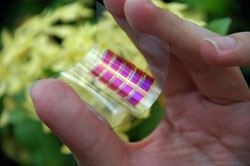New polymeric material brings companies one step closer to cheaper plastic solar cells and electronics

Flexible, organic solar cells – IMRE’s polymer can help save costs and resources in making devices like organic solar cells and next generation printed circuits on plastic. <br>Copyright : Agency for Science, Technology and Research (A*STAR) <br>
A single polymer that can be used in both new age plastic electronics as well as plastic solar cells could spell greater cost-savings and open up new design options for electronic and solar cell companies.
A*STAR’s IMRE has developed a new polymer that not only produces a high charge mobility of 0.2 cm2/V.s, which is the same value achieved by commercially available semiconducting materials but also has a high solar power conversion efficiency of 6.3%. This makes IMRE’s polymer one of the few that has both these properties. In addition to this, polymers of the same class as IMRE’s, which are those that use thiophene and benzothiadiazole as the building blocks, could only achieve 2.2% power conversion.
“Current polymers are usually good in one aspect or another, either as a good conductor for use in electronics or endowed with high power conversion efficiency – but not both”, said IMRE Senior Scientist, Dr Chen Zhi Kuan, the principal researcher working on the polymers. “IMRE’s polymer functions not only as a good material to make electronic components, the same material can be used to convert sunlight to electricity efficiently”. The polymer can also be easily applied in roll-to-roll printing techniques which is similar to how newspapers are currently printed making it possible to manufacture large area-scale printed electronics and organic solar cells quickly and cheaply.
With IMRE’s polymer, manufacturers could save cost using just a single bulk resource for making both printed electronics and organic solar cells. The material could also possibly be used in designing new devices where both power harnessing and electronics are needed in a single component. An example of this would be chemical sensors based on organic thin-film transistors and powered by organic solar cells.
“This breakthrough will help speed up the development of plastic electronics and organic solar cells, and make them more readily available in the marketplace,” said Prof Andy Hor, Executive Director of IMRE.
Printed electronics often rely on organic materials like polymers that can be easily processed and manufactured as opposed to traditional electronics (or metal electronics) which rely on inorganics such as copper or silicon. The polymers can be made into thinner, lighter and cost-effective electronic components and organic solar cells.
The IMRE team is developing other organic materials-based polymers that can be scaled up to production and integrated easily into organic electronics. These materials can be used to make energy harvesting and low-power consumption devices like low-cost organic solar cells, new flexible display devices, next generation smart labels and RFID tags.
The research and results were recently published in the Advanced Materials journal and online at the Nature Publishing Group (NPG) Asia Materials in July 2011.
For media enquiries, please contact:
Mr Eugene Low Manager, Corporate Communications
for Institute of Materials Research and Engineering (IMRE)
3, Research Link
Singapore 117602
DID +65 6874 8491
Mobile +65 9230 9235
Email loweom@scei.a-star.edu.sg
For technical enquiries, please contact:
Dr Chen Zhikuan
Senior Scientist
Institute of Materials Research and Engineering (IMRE)
3, Research Link
Singapore 117602
DID +65 6874 4331
Email zk-chen@imre.a-star.edu.sg
About the Institute of Materials Research and Engineering (IMRE)
The Institute of Materials Research and Engineering (IMRE) is a research institute of the Agency for Science, Technology and Research (A*STAR). The Institute has capabilities in materials analysis & characterisation, design & growth, patterning & fabrication, and synthesis & integration. We house a range of state-of-the-art equipment for materials research including development, processing and characterisation. IMRE conducts a wide range of research, which includes novel materials for organic solar cells, photovoltaics, printed electronics, catalysis, bio-mimetics, microfluidics, quantum dots, heterostructures, sustainable materials, atom technology, etc. We collaborate actively with other research institutes, universities, public bodies, and a wide spectrum of industrial companies, both globally and locally.
For more information about IMRE, please visit www.imre.a-star.edu.sg
About the Agency for Science, Technology and Research (A*STAR)
The Agency for Science, Technology and Research (A*STAR) is the lead agency for fostering world-class scientific research and talent for a vibrant knowledge-based and innovation-driven Singapore. A*STAR oversees 14 biomedical sciences and physical sciences and engineering research institutes, and six consortia & centres, located in Biopolis and Fusionopolis as well as their immediate vicinity.
A*STAR supports Singapore's key economic clusters by providing intellectual, human and industrial capital to its partners in industry. It also supports extramural research in the universities, and with other local and international partners.
Media Contact
All latest news from the category: Materials Sciences
Materials management deals with the research, development, manufacturing and processing of raw and industrial materials. Key aspects here are biological and medical issues, which play an increasingly important role in this field.
innovations-report offers in-depth articles related to the development and application of materials and the structure and properties of new materials.
Newest articles

Superradiant atoms could push the boundaries of how precisely time can be measured
Superradiant atoms can help us measure time more precisely than ever. In a new study, researchers from the University of Copenhagen present a new method for measuring the time interval,…

Ion thermoelectric conversion devices for near room temperature
The electrode sheet of the thermoelectric device consists of ionic hydrogel, which is sandwiched between the electrodes to form, and the Prussian blue on the electrode undergoes a redox reaction…

Zap Energy achieves 37-million-degree temperatures in a compact device
New publication reports record electron temperatures for a small-scale, sheared-flow-stabilized Z-pinch fusion device. In the nine decades since humans first produced fusion reactions, only a few fusion technologies have demonstrated…





















